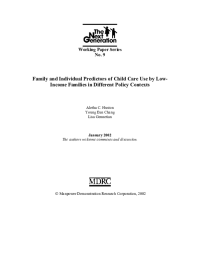Family and Individual Predictors of Child Care Use by Low-Income Families in Difference Policy Contexts
Summary of Key Findings from Working Paper No. 9
Background
A wide range of family circumstances affect the child care needs of low-income parents, and policies affecting child care availability and funding must take this diversity of needs into account. Using information from three demonstration programs that promoted employment and offered enhanced child care assistance, this paper examines how family structure, human capital endowment, geographic location, ethnic group identification, and psychological and social characteristics affect low-income parents’ use of child care, problems with child care that impede getting or keeping a job, and receipt of public child care subsidies. Each program randomly assigned parents to a program group receiving the program services or a control group who were eligible for federally and locally funded child care assistance available in their locale. Characteristics of participants when they entered the study were used to predict child care patterns over the subsequent one to three years.
Key Findings
- Individual differences predicted whether parents used center-based care. Those with fewer children and younger children, better education, more work experience, and personal beliefs in the compatibility of work and family responsibilities were most likely to use center care. Beliefs and values parents held about work and family, their expectations about the future, and their sense of personal control also influenced decisions about how much child care they used and whether that care was home based or center based.
- Few parents — including teen mothers — lived with another adult, but those who did tended to use care provided by relatives. These parents did not report fewer child care problems, however, suggesting that relative care is not an adequate solution for addressing the child care needs of most low-income parents.
- There were no consistent differences in use of child care by parents in different racial and ethnic groups. This suggests that generalizations about ethnic differences in child care preferences should be interpreted with caution.
- Policies designed to reduce the cost of care and to increase parents’ employment affected particularly the child care decisions of families with many children and those whose children were very young. These policies may have alleviated specific difficulties they experience, such as having to find infant care or to juggle multiple work schedules and care-giving arrangements to accommodate siblings of different ages. These policies were also more effective in serving the needs of parents with less consistent prior employment experience.
Conclusions and Implications
Child care assistance policies can be designed to complement welfare and employment programs to address the varying circumstances and preferences of low-income parents. These same policies, however, did not help families overcome non-child care barriers to employment. Families with these barriers (such as a lack of reliable transportation) may require a broader mix of employment and child care support than were provided in these programs.







